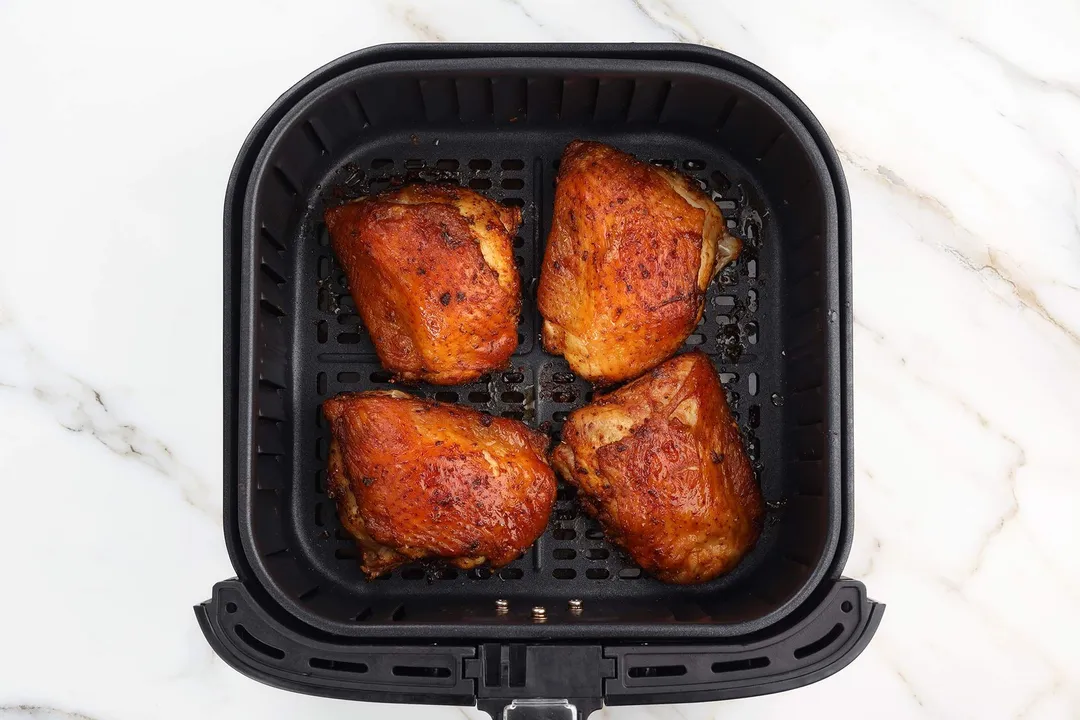How long should you cook chicken in an air fryer?
For sure it’ll take less time than baking but a little more than pan-searing. We’d say it’s 15-25 minutes depending on the cuts, but that’s not all there is. If you’re using frozen meat, if the meat is boneless, or if it’s cut into smaller pieces, etc. then it’s a whole different story. There’s no definite answer to this question.
Today’s how-to will give you the full details on the nuances.
How Long to Cook Chicken in an Air Fryer
With an oven, it usually takes around 5-7 minutes to warm up. The time may be longer if the oven’s big. Air fryers, on the other hand, come in sizes with minimal variations and warm up in a matter of seconds. In other words, you’ll save 5-7 minutes just by using an air fryer instead of the oven.
- Bone-in Cuts
The thigh, leg, breast, and wing all have different cooking times, but unlike baking, the differences are minimal. At 350°F, all should be cooked in 25 minutes, starting from room temperature.
You can cook these cuts at a higher temperature, but then the inside might be undercooked. Unlike beef steak, which some prefer rare, chicken should always be fully cooked to an internal temperature of 165°F.

- Boneless Cuts
With the bones removed, the thigh and leg should be flat pieces 1/4” in thickness that cook in 15 minutes at 350°F. The breast, usually 1/2” in thickness, takes around 20 minutes. The chicken tender, as a smaller size, should be fully cooked in just 7 minutes. All should be at room temperature.
See our post: how long to cook chicken breasts in air fryer.
- Frozen Cuts
Never put frozen meat straight into the air fryer. After seasoning it thoroughly you’ll want to wrap it in foil and put it in the air fryer to thaw it. The temperature should be 325°F.
With different structures and thickness, each frozen cut requires a different thawing time:
- Bone-in leg: 25 minutes
- Bone-in thigh, breast: 20 minutes
- Bone-in wing: 7 minutes
- Boneless cuts 1/2” thick: 20 minutes.
- Boneless cuts 1/4” thick: 15 minutes.
And yes, that's just for thawing. The process takes a lot of time all right, but it makes a really good point: always remember to thaw your meat.
When the time’s up, carefully open the foil to avoid any steam or juice from hitting you. Put the chicken aside, carefully lift the foil, and transfer the liquid to another bowl. Add the chicken back in and it should take 25 minutes at 350°F for bone-in cuts, and 15-20 minutes for boneless cuts as usual. The liquid can be discarded if too oily, but if not, it adds plenty of flavors to soups.
The meat tends to be dryer when cooked from frozen. The thighs, legs, and wings are more forgiving because they’re tender, but the breasts aren’t quite so.
Rather than cooking the breasts like this, we recommend making nuggets.
- Nuggets
The breadcrumb coat traps moisture and prevents your meat from drying out. It’s our trick when it comes to cooking frozen chicken breasts. Either that or we make soups.
Now, it can be tough to slice into a frozen piece of chicken breast, so thaw it out first. Wrap it in plastic wrap, give it a 30-minute cool water bath, remove the wrap, and it’ll cut pretty easily. If you have moved it from the freezer to the fridge the night before, it’ll cut like fondant.
To ensure that the nuggets are cooked thoroughly, cut them into 1/4” cubes. They’ll take 15 minutes (20 if frozen) at 350°F.
- Chicken and Vegetables
Thick vegetables like potatoes, sweet potatoes, carrots, beetroots, etc. take longer to cook than chicken and require a lower cooking temperature. But if the chickens are cooked at this temperature (especially the breasts), they’re most likely to turn out dry.
The solution would be to wrap the chicken in foil, then adjust the temperature to 350°F. In 25 minutes, the veggies should be roasted and the meat should be just cooked. Put the veggies aside, then roast the chicken at 400°F for 5 minutes for a golden finish.
- Skewers
Since we can’t cook the meat and whatever veg on the sticks separately, choose veggies that cook in about 15 minutes only (at 350°F). We suggest bell pepper, onion, zucchini, tomato, pineapples, etc.
Luna Regina
Writer, Author

